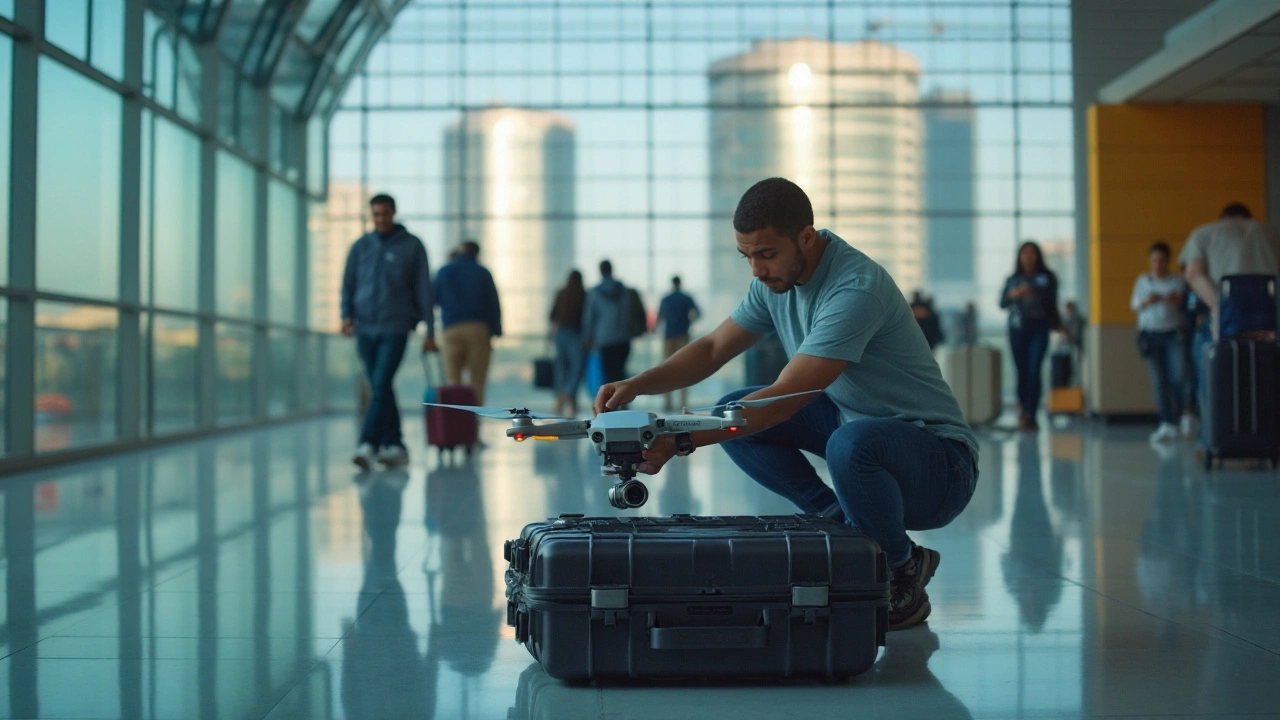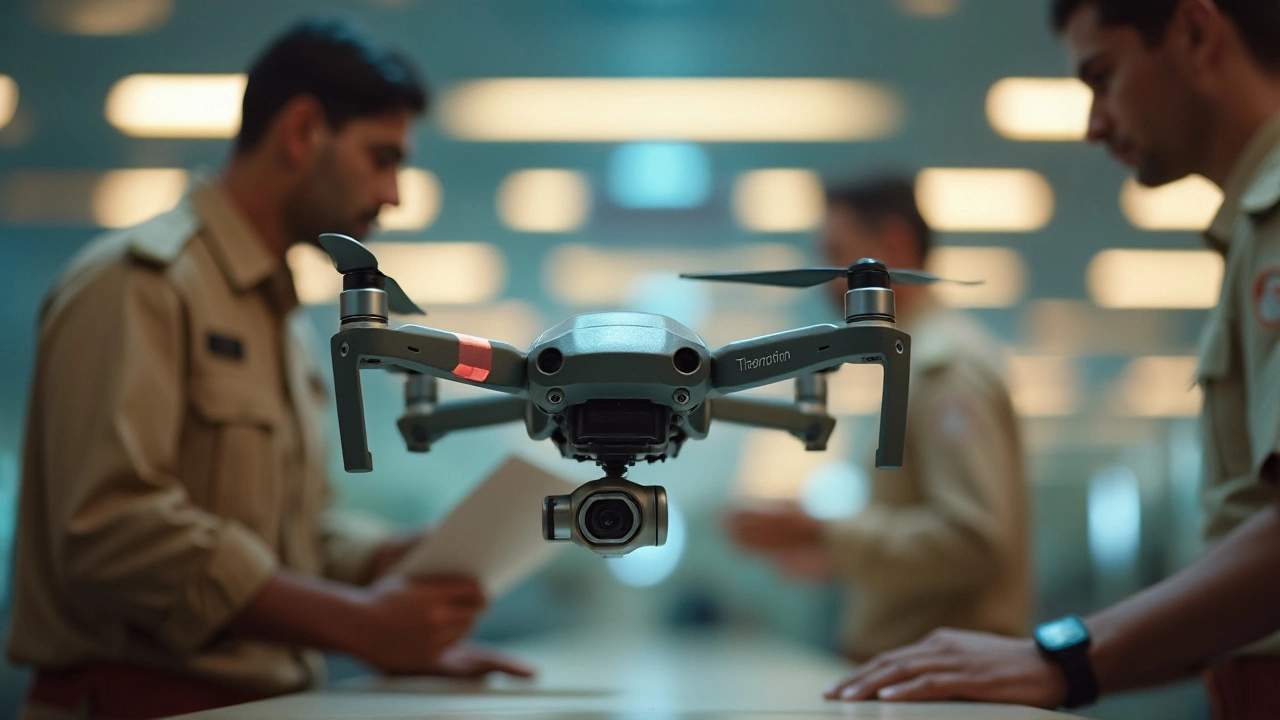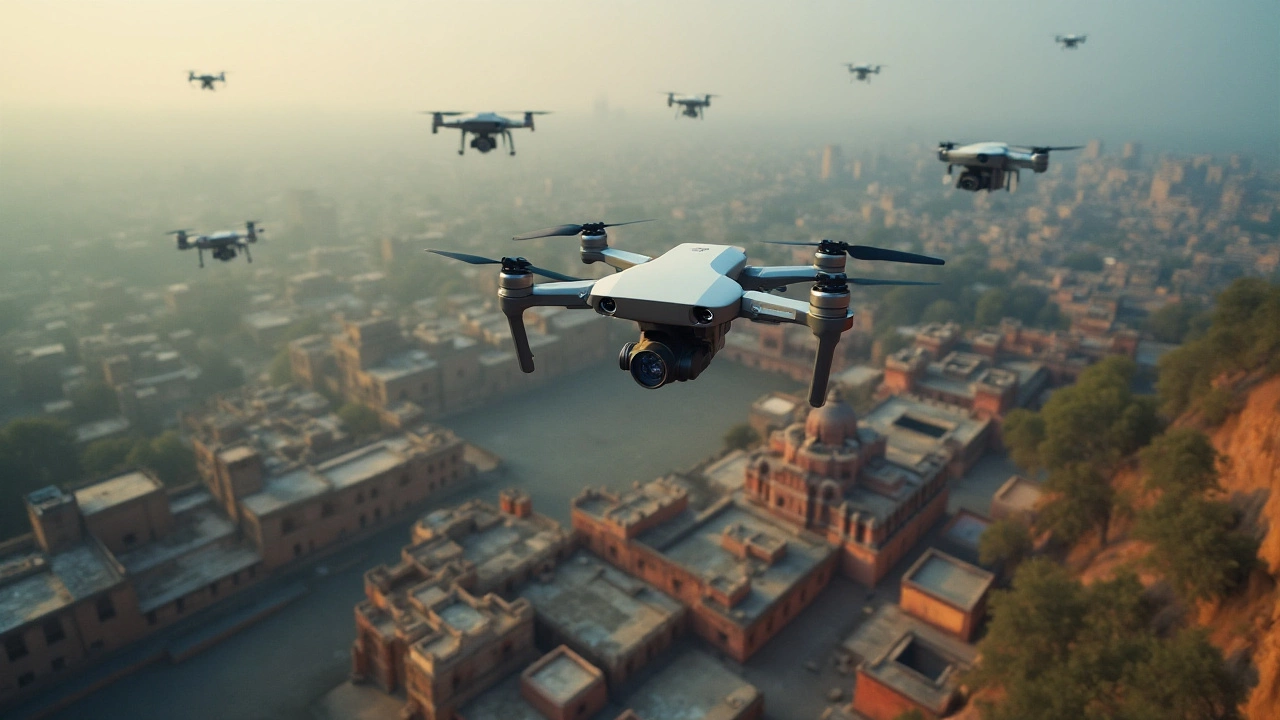Navigating Drone Travel: Dubai to India Guide
 Jan, 17 2025
Jan, 17 2025
Bringing a drone from Dubai to India can be exciting, especially for photography enthusiasts hoping to capture India’s vibrant landscapes. However, it's not as simple as packing it in your bag and heading to the airport. Drones, being sophisticated electronic devices, are subject to various regulations and policies that one must be acutely aware of before making the journey.
This guide walks you through the essentials of traveling with a drone, highlighting the crucial points that'll safeguard your equipment and ensure compliance with both Dubai and India’s legal frameworks. Spare yourself the unexpected airport obstacles and dive into the world of drone travel with confidence.
- Understanding Drone Regulations in Dubai
- Indian Drone Import Laws
- Airline Policies for Drone Carriage
- Customs Procedures and Documentation
- Tips for Safe Drone Transport
- Exploring Drone Photography Opportunities in India
Understanding Drone Regulations in Dubai
Navigating the drone regulations in Dubai is essential for anyone considering bringing a drone to India. Dubai, known for its advanced urban landscape and progressive regulations, imposes specific rules to ensure the safe and responsible use of drones. In Dubai, drones are overseen by the Global Headquarters of Dubai Civil Aviation Authority (DCAA) and the regulations are designed to ensure airspace safety while protecting privacy. This involves a blend of permissions and registrations that must be secured before taking off for any purpose, including photography.
Before operating a drone, users are required to obtain a Remote Pilot Certificate issued by relevant authorities. This involves an assessment process where knowledge of airspace rules is tested. Additionally, drone operators in Dubai must also comply with specific no-fly zone guidelines, which are extensive given the city's proximity to airports and governmental facilities. Areas like downtown Dubai are typically restricted, making it crucial for operators to check maps provided by authorities. The process also includes a requirement to have a third-party liability insurance to cover potential incidents or accidents.
According to a representative statement from the DCAA: "Safety is our utmost priority. Ensuring each drone operator adheres to our regulations protects not only airspace but also the privacy and security of residents."
For hobbyists and professionals alike, the first step in lawful drone usage involves registering the drone with the Dubai Aviation Civil center. The registration mandate entails providing detailed information about the device, including technical specifications and identification details. The legislation applies equally to both recreational and commercial drones, which should be under 5 kg for personal use without needing additional permission, whereas heavier drones for commercial use necessitate additional clearances.
The widespread implementation of these regulations underscores the significance of securing all documentation and permissions to avoid hefty fines or confiscation, which could make it challenging for an enthusiast aiming to take a drone to India. Once all necessary prerequisites are fulfilled, enthusiasts can concentrate on honing their drone photography skills amidst the visually stunning cityscapes, all while remaining compliant with set guidelines.
Indian Drone Import Laws
India has a rich tapestry of cultural diversity and dramatic landscapes that are a haven for drone photography enthusiasts. However, anyone considering bringing a drone into the country from abroad, such as from Dubai, must first negotiate a detailed regulatory framework. The Indian government, through the Directorate General of Civil Aviation (DGCA), lays out specific guidelines that dictate how drones can enter and operate within its borders. The focal point of these regulations is to ensure both public safety and national security. Before you pack your drone for the journey, acquaint yourself with these rules to avoid any complications at customs.
To start, all drones in India must be registered, and this includes those brought from overseas. As per DGCA's rules, any drone weighing over 250 grams requires a Unmanned Aircraft Operator Permit (UAOP). It's important to acquire this permit before arrival to avoid customs delays. Immediate registration after importation is essential because flying an unregistered drone can lead to severe penalties. The permit application process involves several steps, such as obtaining a Unique Identification Number (UIN) for your drone, which should be visibly affixed to the aircraft.
Another pivotal aspect pertains to the import duties and permissions necessary from the customs department. Since drones are classified under the high-value electronic items category, they attract specific import duties which must be calculated while planning your expenses. Ensuring you have all relevant paperwork ready at customs will expedite this process. For the smoothest transition, it’s advised to prepare detailed invoices, registration documents, and any necessary clearances obtained prior to travel. Interestingly, a survey conducted in 2023 revealed that over 60% of drone owners interviewed were unaware of these import duties before traveling, highlighting the common oversight in planning.
In addition to governmental protocols, travelers must take note of regional regulations within India. Certain states have more stringent rules, especially in sensitive border areas where flying drones might be restricted due to security concerns. Therefore, research your specific destinations in advance. Awareness about airspace restrictions is imperative to avoid unintentional breaches which could lead to confiscations or fines.
According to a DGCA spokesperson, "Understanding local and national regulations is crucial for any drone operator. Compliance ensures both personal safety and the protection of privacy and sensitive zones."
Lastly, before embarking on your journey, consult with knowledgeable travel advisors or legal experts who specialize in import regulations. They can provide advice tailored to your specific scenario, such as the drone model you own or the areas in India you plan to visit. By meticulously planning each step of the process from Dubai to India, you can ensure a hassle-free experience as you embark on capturing India's beauty from above with your drone.

Airline Policies for Drone Carriage
When it comes to flying from Dubai to India with a drone, understanding airline policies can be the bridge between a hassle-free journey and unexpected trouble at the airport. Here's the first thing to know: not all airlines have uniform rules regarding the transportation of drones. It's crucial to check with your specific carrier to get the latest updates on their drone travel guidelines. Generally, drones are allowed in carry-on baggage rather than checked luggage. This helps in preventing damage from rough handling and keeps the sensitive equipment safe.
Most major airlines, like Emirates and Etihad, prefer that you keep your drones in the cabin rather than in the cargo hold. The primary reason behind this preference is that drones, especially their lithium batteries, pose a potential fire hazard. The International Air Transport Association (IATA) provides detailed safety regulations involving the carriage of lithium batteries, and airlines often adhere strictly to these guidelines. The IATA recommends that passengers carry spare lithium batteries in their carry-on baggage.
Checking with your airline on the limitations on battery watt-hours for drones is essential. Commonly, batteries less than 100 watt-hours are allowed without prior approval, while those up to 160 watt-hours may require the airline's consent. Also, always disconnect batteries from the drones and pack them separately in battery-safe bags to prevent any short circuit issues.
"Safety and compliance are our highest priorities. We advise verifying battery standards and carrying requisite documentation," an Emirates spokesperson once noted in their travel advisory.
Security checks at airports will involve scanning your drone, and sometimes, security personnel may request you to show that the drone’s battery is separate from the device. Be prepared to demonstrate that the drone is a legitimate electronic device by turning it on without attaching the propellers. Many airlines also ask for drones to be well-protected in transit cases to avoid physical damage. It's a good idea to invest in a sturdy, compact travel case designed specifically for drones, which provides additional protection during travel.
Some airlines also impose limitations on the number of spare drone batteries you can carry. Usually, carrying two or three spares that fit the watt-hour criteria is acceptable, but more may require justification and immediate approval. Reviewing any specific mandates about drone photography equipment from the airline's official website before your trip is always beneficial. These guidelines can be updated regularly to reflect the latest security protocols.
In conclusion, to ensure a smooth journey with your drone from Dubai to India, savvy travelers keep themselves informed about various airline restrictions and adhere strictly to the stipulated regulations. By doing so, they not only ensure the safety of their beloved drone photography gear but also contribute to a safer travel environment for all passengers.
Customs Procedures and Documentation
Traveling with a drone from Dubai to India requires careful navigation of customs regulations, a process that, if mismanaged, can lead to unnecessary hassles or even confiscation of your device. In Dubai, customs procedures generally revolve around ensuring that your drone isn't carrying prohibited technology or materials. It's crucial to have a clear understanding of both countries' import rules when you decide to transport your flying gadget. First, before even heading to the airport, verify that your drone complies with Indian aviation standards. India allows the import of drones but has specific guidelines concerning model specifications and usage. The Bureau of Civil Aviation Security in India has documents outlining these standards, making them a critical resource for travelers.
Customs documentation is no less important. To be on the safe side, always carry the purchase receipt and any legal paperwork that ascertain the ownership. The receipt should clearly mention the price as this will help in calculating duty charges upon your arrival. You may need to fill out a Passenger Declaration Form, which is a straightforward process but mandates transparency about every electronic item you're carrying, especially if they're worth more than the allowed limit. Additionally, some airports might ask for product brochures or manuals to corroborate the drone's non-commercial use.
"Understanding customs documentation can significantly smooth out the experience of transporting a drone across borders," notes aviation expert Amit Lal, who emphasizes the importance of thorough preparation.Before the actual travel, it's wise to check airline-specific policies for drone carriage. Most airlines allow drones as part of your checked baggage but ensure that the batteries are separately packed in carry-on luggage due to aviation safety rules. Lithium batteries have been under scrutiny for their flammability risks, prompting this stringent policy. Confirm the battery size limitations as per International Air Transport Association guidelines, typically permitting batteries below a certain watt-hour.
As you prepare for departure, ensure all necessary documentation is compiled in advance. A drone serial number registration in India might be necessary under the Digital Sky Platform, introduced by India's Directorate General of Civil Aviation. This online registration is part of India's unmanned aircraft regulations, aiming to keep track of all private drones in operation. Without this documentation, entry might be denied, posing additional stress you definitely want to avoid. Handling customs procedures efficiently will allow you to focus on the more exciting aspects of travel, like exploring India's stunning drone photography locations. Remember, a little preparation goes a long way in making your cross-border drone travel a seamless experience.

Tips for Safe Drone Transport
Embarking on a journey with a drone from Dubai to India requires more than just packing enthusiasm for drone photography. Careful planning ensures the safety of your equipment and compliance with regulations at every stage. Start by investing in a high-quality drone case designed for air travel. These cases offer robust protection from physical damage and are customized to securely fit your device and its components, reducing the risk of jostling during transit. A well-padded interior and sturdy exterior can prevent breakages, which might occur during baggage handling or unexpected bumps.
Before the flight, it's essential to remove all attached batteries from your drone and store them safely in your carry-on luggage. Most airlines mandate that lithium batteries be carried in the cabin due to fire safety protocols because they are prone to overheating. Follow the airline's specific battery regulations, which typically limit the maximum Wh (watt-hour) rating for each battery. Ensure you pack them in flame-retardant, Lipo-safe battery bags to minimize hazard risks, thus safeguarding yourself and fellow travelers.
Understanding the customs procedures is another crucial aspect. Review the customs policies regarding electronic items both in Dubai and at your destination in India. Have all necessary documents, such as purchase receipts, warranties, and any other paperwork that can prove the ownership and value of your drone. This can expedite the customs clearance process significantly. It might also be prudent to declare your drone upon arrival, even if it isn’t required, to avoid misunderstandings and possible fines.
Drone journey enthusiasts should also be aware of the climate changes that may affect both the operation and storage of their equipment. India’s humid weather can sometimes require special maintenance conditions or storage methods to maintain drone functionality. Using silica gel packs in your carry case can help control moisture levels and protect sensitive electronics against humidity-induced corrosion or damage.
Moreover, when it comes to insurance, nothing beats the peace of mind it offers. Look for travel insurance plans that cover electronic gadgets, including drones, against theft, loss, or damage. Insurance providers often offer specialized coverage policies for drone travel, ensuring that you’re financially protected against unforeseen mishaps. As a famous aviator, Amelia Earhart, once said,
"Preparation, I have often said, is rightly two-thirds of any venture."In this context, being thoroughly prepared is the best way to ensure a hassle-free experience.
Meeting legal requirements diligently is the key to worry-free drone transport. Each country has its own set of rules regarding bringing in drones, and India's Directorate General of Civil Aviation has comprehensive guidelines in place. These specify categories of permitted drones, import requirements, and necessary licenses. Researching these before you travel not just saves time but also aligns with your plan to capture mesmerizing Indian landscapes legally and with ease.
Exploring Drone Photography Opportunities in India
India, often heralded as a land of diverse landscapes and rich cultural tapestry, offers a treasure trove for drone photography. The vast subcontinent teems with breathtaking vistas that can best be captured from the sky. From the majestic Himalayas in the north to the serene backwaters of Kerala in the south, the country’s geographical variety calls for aerial exploration. Perhaps nowhere is this more evident than in Rajasthan, where the stark beauty of the Thar Desert juxtaposes with the intricate architecture of historic forts and palaces. Using a drone to photograph the expansive Jaisalmer Fort at sunset can yield stunning images that few traditional cameras can match.
Modern cities like Mumbai and Delhi present a different allure for drone enthusiasts. The bustling life, coupled with iconic structures like the Gateway of India and the Red Fort, provide dynamic backdrops. Capturing the vibrant urban sprawl from above can offer a fresh perspective, far removed from the everyday view on the ground. When photographing such popular tourist destinations, it's crucial to adhere to local regulations and restrictions to avoid legal issues. It's always wise to check the latest drone flying policies in India as they can often be updated without prior notice.
Nature lovers and wildlife photographers will find joy in vast areas like the Sundarbans and Jim Corbett National Park. Here, drones can be particularly useful in observing wildlife while maintaining a respectful distance. Of course, one must exercise caution and ensure flights are conducted legally and ethically, respecting both nature and the inhabitants of these protected areas. Indian wildlife conservation laws are stringent, designed to protect the rich biodiversity, and thus any aerial photography must be planned with careful consideration.
Beyond still photography, drones open a new realm for videography. Capturing India's cultural festivals, such as Holi or Diwali, from the air can create compelling video narratives. The dizzying sweep of colors and light is ideally suited to aerial panoramas, though cultural sensitivity and respect for privacy are paramount when documenting such personal celebrations. The Ministry of Civil Aviation's guidelines on drone use during public events should be strictly followed to ensure a seamless and respectful experience.
Drone travel isn’t just about the equipment or the images; it’s about connecting with the place you’re capturing. Suman Prasad, a renowned Indian landscape photographer, once said,
"The true essence of a place reveals itself to those who are willing to pause and perceive beyond the lens."His words resonate with the philosophy of drone photography in India—it's about telling a story as ancient and varied as the lands themselves. Practicing patience and respect towards the environment and communities, drone photographers can indeed illuminate the unseen wonders of this captivating country.
For those venturing into less explored regions, the Northeastern states offer some of the most pristine landscapes. States like Meghalaya, with its living root bridges, present ethereal images from an aerial perspective. Similarly, the tea gardens of Assam or the serene lakes of Kashmir invite drones to capture their tranquil beauty. Each state, with its unique topography and climate, presents distinctive challenges and opportunities for drone enthusiasts.
As exciting as drone photography can be, it comes with a responsibility to conduct oneself in a manner that respects India's local laws and cultural norms. By staying informed and showing due regard, drone enthusiasts can uncover and document the astonishing beauty of India from the skies, furthering the art of photography in a nation teeming with stories waiting to be told.